| Pages:
1
2
3 |
jdowning
Oud Junkie
    
Posts: 3485
Registered: 8-2-2006
Location: Ontario, Canada
Member Is Offline
Mood: No Mood
|
|
To complete this part of the investigation - pending such time as a sufficient quantity of vine wood can be collected to be seasoned and made into an
oud bowl - here is a better estimate of the specific gravity of vinewood under test. Specific gravity is generally directly related to the hardness
of a wood so is useful for relative comparative purposes.
The Forest Products Laboratory of the U.S. Department of Agriculture handbook, 'The Encyclopedia of Wood', is a comprehensive reference about
domestic species of wood in the USA and its properties.
The Specific Gravity of a wood may be defined as the weight of a wood sample when oven dried divided by its volume at a specified moisture content
compared to the density of water. For moisture content below about 30% (the lower limit for green wood), if the specific gravity is known at a certain
moisture content, its S.G. may be determined by extrapolation at any other moisture content. The specific gravity based on an oven dry weight standard
does not change for moisture content above 30%.
Using this standard to calculate the S.G. for the two samples of vinewood under test, it was found that Sample 1 had an S.G of about 0.50 (this sample
was assumed to be 'green' at moisture content of about 29%) and Sample 2 an S.G. of 0.49.
Extrapolating to a lower moisture content of 12% (air dry lower limit) - using the conversion charts in the U.S. Forestry Service handbook - gives a
specific gravity of about 0.54 and at 8%, about 0.55.
Wood is a variable material so specific gravity might range by 5% plus or minus from an average value for domestic species but can be a much wider
variable for tropical hardwoods.
For comparison here are some wood specific gravities based on the oven dry standard at 12% moisture content.
English Sycamore 0.47 to 0.51
Sugar Maple 0.63 to 0.66
European Beech 0.61 to 0.67
White Ash 0.57 to 0.63
Black Walnut 0.52 to 0.58
European Elm 0. 47 to 0.51
Indian Rosewood 0.76 average
Ebony 0.90 average
Mahogany 0.43 to 0.75
Pacific Yew 0.59 to 0.63
Fir 0.38 average
Larch 0.53 average
Engleman Spruce 0.34 average
Sitka Spruce 0.40 average
|
|
|
jdowning
Oud Junkie
    
Posts: 3485
Registered: 8-2-2006
Location: Ontario, Canada
Member Is Offline
Mood: No Mood
|
|
" We'll lounge beneath the pomegranates, palm trees, apple trees, under every lovely, leafy thing, and walk among the vines, enjoy the splendid faces
we will see. in a lofty palace built of noble stones" Ibn Gabirol, 11th C.
This poetic reference is part of the opening sequence of the recent PBS program "Cities of Light" - about Al-Andalus. It confirms that vines were part
and parcel of the everyday lives of Moorish kings and their courts.
Does anyone have access to the original Arabic text - just to verify - from a different source - Dr Farmer's translation of the word "mais" as "vine"?
|
|
|
jdowning
Oud Junkie
    
Posts: 3485
Registered: 8-2-2006
Location: Ontario, Canada
Member Is Offline
Mood: No Mood
|
|
A little off topic but, still - almost - related.
This afternoon my wife announced that she had decided to give me her microwave oven "in the interests of science" (Well, actually she wants to buy a
new one to replace it after I have been messing around with it - but that is another story and as basic microwave ovens are quite inexpensive these
days - no problem). I shall use this new found tool to carry out accelerated wood drying experiments - as well as to brew coffee in my workshop. There
is a lot of information 'on line' about microwave drying of wood - particularly among the wood turning fraternity - so it should be an interesting
field to explore further.
I am not a microwave oven enthusiast, however, as the last one that she gave me was promptly converted into a mini 'spot' welder - well, the
transformer was - stripped down and rebuilt. (Warning - never, ever, mess around with the components of microwave ovens unless you really know what
you are doing as the voltages involved (even after the power is switched off) are lethal - a.k.a. instant death!).
Microwave drying of wood might possibly develop into the topic of a future thread.
|
|
|
jdowning
Oud Junkie
    
Posts: 3485
Registered: 8-2-2006
Location: Ontario, Canada
Member Is Offline
Mood: No Mood
|
|
Trying to find a better understanding about the identification of the woods in Dr Farmer's translation of the Kitab kashf al-humum, I came across an
excellent website dealing, in depth, with plants of conservation concern to India - a site supported by the Government of India. The data base
includes descriptions of plants identified by both botanical and the (present day) vernacular names in many languages including Arabic, Persian,
Hindi, Sanskrit, English etc.
http://envis.frlht.org.in
None of the names given by Farmer for Beech, Elm, Walnut or Vine could be found in the data base with the exception of "sasam" which is one of the
vernacular names in Arabic for a species of rosewood, Dalbergia Sissoo. This is not the true (East) India Rosewood, Dalbergia Latifolia (Shisham in
Hindi), native to the Bombay region of India, but is today often used as a substitute for Dalbergia Latifolia. The species Dalbergia Sissoo is
distributed as far west as Iraq so, presumably was (and still is) a tree native to Persia.
The alternative words for Walnut given by Farmer (saz and shiz) are likely Persian in origin (?) - saz being the name for the musical instrument and
shiz being the site of Takht-e Soleiman (Throne of Saloman) in ancient Persia, Azarbaijan province. The wood - whatever it was - perhaps being
originally used for making the saz and coming from that region of Persia?
Walnut or Persian Walnut, originated in Northern Persia and was introduced to Europe by the Romans. The ancient Greeks regarded it as a royal wood
which is today reflected in its botanical name 'Juglans Regia' - another wood fit for a king!? The largest Walnut plantation (for nut production) in
the world today is the Shahmirzad orchard in Iran - over 700 hectares in area. Also there are vast Walnut forests covering over 230,000 hectares
further east in Kirghistan. So Walnut is a wood that must have been very plentiful in Persia and the Middle East in ancient times.
The identification of woods by their vernacular name today may not be the same as it was in ancient times - therefore the above does not really
clarify the position. So, what was the basis for Dr. Farmer's translation? Is there a modern dictionary of ancient Persian or Arabic - referenced by
those involved in the study of early languages of the Middle East - where these words, now obsolete in everyday usage, might be found?
|
|
|
jdowning
Oud Junkie
    
Posts: 3485
Registered: 8-2-2006
Location: Ontario, Canada
Member Is Offline
Mood: No Mood
|
|
As Fall (Autumn) is now upon us, and the leaves are falling, I have decided to cut some of the more interesting wild grape vine stock from my wood lot
at the same time as I cull dead wood that will be fuel for heating this winter.
The most promising stock is vine that has grown vertically, on a host tree, to produce relatively straight, twist free growth. Some of this stock is
curved but I hope to be able to straighten this and make it viable, during the natural drying process - given the pliability of vine wood while still
'green'.
The vine wood samples in the attached image ranges from 2 inches (50cm) in diameter to over 6 inches (15 cm) in diameter (!).
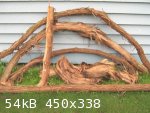
|
|
|
jdowning
Oud Junkie
    
Posts: 3485
Registered: 8-2-2006
Location: Ontario, Canada
Member Is Offline
Mood: No Mood
|
|
The largest diameter root stock (6 inches/15 cm) in the first sample collection is, sadly, useless for instrument making but may be useful for study
in obtaining a greater understanding about vine wood in general. This root stock is badly fissured (radial splits) and, while still alive when cut, is
suffering significant heart rot. In other words, this stock is at the end of its life cycle. Most dramatically, the vine is twisted, beautifully, like
a rope.
I shall section, and determine the age of this sample after preliminary drying.

|
|
|
jdowning
Oud Junkie
    
Posts: 3485
Registered: 8-2-2006
Location: Ontario, Canada
Member Is Offline
Mood: No Mood
|
|
The largest diameter vine stem has been sectioned and planed smooth to reveal the annual growth rings. A ring count indicates that the age of of the
stem is about 60 years - estimating the rotted out section of the stem as representing about 10 years of growth.
The reference scale in the attached image of the sectioned stem is 6 inches/ 15 cm.
Comparing ring counts with the smaller diameter
(2 inch/5.0 cm - 20 years old) vine samples confirms a growth rate of about 10 years per inch of stem diameter for wild vine grown in this
locality.
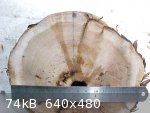
|
|
|
jdowning
Oud Junkie
    
Posts: 3485
Registered: 8-2-2006
Location: Ontario, Canada
Member Is Offline
Mood: No Mood
|
|
This is a pleasant time of year to be walking through the woods and in doing so today I found another three promising looking vine stems - fairly
straight and about 2.5 to 3 inches (64 mm to 76 mm) in diameter. These will be cut tomorrow.
Planning ahead - the vine wood will eventually be used to build a replica of an early 5 course fretted oud (subject of a new topic) - if I can find
sufficient stems of appropriate size and free of significant flaws. The design will be based upon the oud geometry described in the topic "Analysis of
an Early Oud Woodcut" on this forum. This design would appear to be the earliest (and most fundamental) geometry of an oud on historical record.
Choosing an arbitrary (but comfortable for me!) string length of 60 cm for this proposed instrument gives a rib blank length of about 25 inches (635
mm). Rib blank width for a (preferred) 11 rib bowl would then be about 2.1 inches (53mm) or about 1.8 inches (46 mm) for a 13 rib bowl. These
calculated dimensions now give me a target for selecting, cutting and preparing the vine wood stock. This means that - given the limited diameter of
the available vine stems - the rib blanks will be slab sawn.
|
|
|
carpenter
Oud Junkie
    
Posts: 248
Registered: 8-30-2005
Location: Eugene OR
Member Is Offline
Mood: brimming with hope
|
|
That twisted piece is something! I had a 6" dia. limb of plum wood once that spiraled for one turn in a foot for quite a ways up the stick; turned out
to be useless for my needs at the time, but it was a nice conversation piece on the mantel. I couldn't count the rings even with my glasses.
Some Ancient told me fruitwood generally has twisting/spiraling tendencies. Dunno. Could be so; I haven't had enough of it around to tell. Fruitwood's
lovely turning wood when it's straight and behaves.
Interesting posts as usual, and good luck with that vine wood.
|
|
|
jdowning
Oud Junkie
    
Posts: 3485
Registered: 8-2-2006
Location: Ontario, Canada
Member Is Offline
Mood: No Mood
|
|
Thanks Jim. I think that the 'wild' spiral twisted sample of vine should be converted into something 'useful' - like a pencil holder - by boring out
the dead centre and mounting it on a wooden block - not only to preserve it as an unusual conversation piece but as a little piece of history, given
that this vine started life just after the end of World War 2.
I gathered some more vine wood today - the largest being over 3 inches in diameter and about 10 ft long and fairly straight (growing vertically up a
tree. There is more further up but I could not reach it without a ladder). The cut ends of the vine sections collected have all been coated with latex
primer paint to protect against checking (splitting) of the ends due to too rapid drying.
It is inevitable that there will be some degree of twist, local knots and grain 'run out' evident in all rib blanks made from this material. I am
hopeful, however, that the natural flexibility of the vine - previously reported - will allow manipulation of the wood during the natural drying
process to minimise the effect of these natural 'flaws'.
No guarantee that any of this will be successful at the end of the day. Worth a try though.
|
|
|
carpenter
Oud Junkie
    
Posts: 248
Registered: 8-30-2005
Location: Eugene OR
Member Is Offline
Mood: brimming with hope
|
|
<< coated with latex primer paint to protect against checking (splitting) of the ends due to too rapid drying. >>
I had bad luck with latex once upon a time; either it wasn't thick enough or I just messed up, checks galore. I subsequently got great results (with
different wood) with melted paraffin, or "canning wax;" the white stuff. A dip or two did the job. A friend of mine globbed on some aluminum paint on
some oak, and had good results ...
If anybody is drying green wood, the water goes out the ends at a much higher rate than through the sides, so sealing the ends is key - with a capital
Sealing - to minimize checking. Stickers and shade-drying are also good; slow and steady.
Josh - how's drying that nice apple wood going (if you're reading this)?
|
|
|
jdowning
Oud Junkie
    
Posts: 3485
Registered: 8-2-2006
Location: Ontario, Canada
Member Is Offline
Mood: No Mood
|
|
I am using two coats of latex primer to seal the end grain during drying. Primer is a lot thicker than latex top coat paint as it is essentially a
wood sealer. It should be OK for this application and is also 'compatible' with moisture in the freshly cut wood. Paraffin wax will do as well but has
to be melted and is a more fragile coating (tends to break and peel off if knocked accidentally) I have found.
Alternatively, paper glued over the end grain surfaces can be used.
Nevertheless, it is always best to leave extra material at the end of the sawn boards so that any end checking that inevitably might occur can be cut
away after the wood is fully dried.
|
|
|
jdowning
Oud Junkie
    
Posts: 3485
Registered: 8-2-2006
Location: Ontario, Canada
Member Is Offline
Mood: No Mood
|
|
The freshly cut 3 inch diameter stem was cut 48 hours ago and the cut ends painted with latex primer. Yesterday I noticed that the primer had not
dried. Cutting the stock into "straight" sections for converting into rib stock (hopefully!), the sap suddenly started to flow from the cut ends with
a steady 'drip'. Left overnight, with the cut lengths stacked vertically to allow drainage of the sap, the copious sap flow has congealed into a
'jelly like' consistency as shown in the attached image.
Not sure what is going on here but it may be that this is some kind of protective mechanism by vine wood to seal broken stems and ensure continued
healthy growth. Perhaps, artificially, sealing the cut ends, in this case, may not be necessary? So, although grapevine essentially has the cell
structure of a wood it is also 'plant like' (i.e. not 'tree like') in some ways. However, note that some species of wood like sycamore (a kind of soft
maple) when freshly cut - the boards must be initially stacked vertically to accelerate (presumably) initial sap drainage to minimise undesirable
staining of the wood due to retention of the high sugar content sap of the species.
Once this excessive sap flow has ceased, the relatively 'dry' cut ends will be re-coated with latex primer to seal against further rapid moisture loss
to minimise checking.
Nobody said that this was going to be easy!!
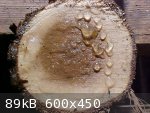
|
|
|
SamirCanada
Moderator
     
Posts: 3404
Registered: 6-4-2004
Member Is Offline
|
|
Ha! neat...
|
|
|
jdowning
Oud Junkie
    
Posts: 3485
Registered: 8-2-2006
Location: Ontario, Canada
Member Is Offline
Mood: No Mood
|
|
Before I forget - for some unknown reason (to me) this seems to have been a very bad year for wild grape on my property with hardly any fruit in
evidence. Not sure if this will have any bearing on this investigation but worth noting nevertheless.
Once the vine stems have been cut to the required length, drained of sap and the partially dried cut ends coated with latex primer, they will be left
to dry further under cover for a couple of weeks or so.
The strategy for cutting the stems into slabs for seasoning into rib blanks will be first to cut each stem in half longitudinally - following the
irregular grain direction as closely as possible. This means, for example, that stems that are curved will be cut in a curve. The curved strips will
then be straightened out, during the seasoning process, by placing them under load in a drying frame. More on this later.
Any soft pith in the centre of the half sections will be cut away at this stage to reduce the risk of heart shakes developing (radial cracks caused by
too rapid drying starting from the central pith).
The attached image shows an example of heart shake in one of the vine samples described earlier in this thread. This sample is a stem 2 inches (50 mm)
in diameter and about 20 years old. The crack is about 8 mm long radially and extends only about 13 mm deep into the stem from the cut end - so is not
as serious at might first appear. This stem had been allowed to air dry without any coating being applied to the cut ends - so has dried a little too
rapidly. An end coating applied at the start of the drying process would most likely have prevented or minimised this fault.
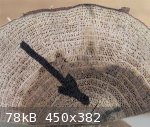
|
|
|
jdowning
Oud Junkie
    
Posts: 3485
Registered: 8-2-2006
Location: Ontario, Canada
Member Is Offline
Mood: No Mood
|
|
As noted in an earlier posting, if a horizontal slab is sawn through a section of vine when it is 'green' and then allowed to air dry, the slab will
dry, naturally, into a curved profile. This is because the wood shrinks (in section) along the 'grain' of the growth rings - the longer the grain
length, the greater the degree of shrinkage. This can be seen in the attached upper image of a slab sawn section from one of the samples previously
posted. This example is a typical slab sawn section with most of the grain running - more or less - across the width of the slab.
Cutting the vine stock in this manner, while still 'green', will further minimise the risk of checking or cracking of the section during the drying or
seasoning process by reducing the stresses involved.
In order to saw rib stock from the slabs, after drying is complete, allowance has to be made for this predictable distortion of the wood. The lower
image shows how rib blanks may be sawn from the dry but distorted slab - the upper and lower curved surfaces first being planed level and the dressed
slab then being sawn in two (if there is sufficient material thickness remaining). In this case (for a 2 inch diameter vine stem) a slab initially
measuring about 1/2 inch (12 mm) in thickness when 'green' should be sufficient to provide two rib blanks of adequate width and thickness when sawn.
This equates to four rib blanks per stem. Larger diameter stems should provide even more rib blanks of greater or equal width.
Note that rib blanks cut in this manner would have a grain direction somewhere between 'slab' and the 'quarter' sawn ideal.
So, this is the planned strategy for dealing with small diameter vine stems. Time will tell if it succeeds or fails!
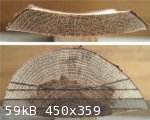
|
|
|
jdowning
Oud Junkie
    
Posts: 3485
Registered: 8-2-2006
Location: Ontario, Canada
Member Is Offline
Mood: No Mood
|
|
The wild vine collected so far has been cut into lengths of about 28 inches (72 cm) and the loose fibrous bark stripped off. Stripping the bark
revealed hidden severe faults in some of the vine samples like deep fissures and extreme twisting. Also, many of the samples suffered from heart rot.
All of these faults make the wood useless - well, only good for burning.
Of all the samples collected, the 3 inch diameter stems are the most promising but less than ideal as none of these are straight grained but curve and
twist to a certain extent. In light of this, I have decided to slab cut these sections along an 'average' two dimensional plane which means that the
sections cut from this stock will be curved. However, as oud ribs taper from end to end, I am hopeful that - given the width of the sawn stock (3
inches max.) - that there will be sufficient scope to produce ribs of adequate dimensions from this curved
slab cut stock.
The 3 inch stems are still very 'green' so I do not want to leave them in this state for very long before re-sawing them into slabs for drying
(seasoning), in order to reduce the risk of checking (splitting of the wood).
To re-saw the stems, a simple carriage was built to hold the stem safely and securely while being sawn in a bandsaw. My carriage was made from a piece
of scrap 3/8 inch (10 mm) thick plywood screwed to a 3/4 X 2 inch wide (19mm X 50mm) pine base. All very 'rough and ready' but good enough for the
job.
Each section of vine stock was mounted in the carriage in a vertical plane (all done 'by eye' - a 'judgement call' for each piece) and then cut in
three pieces by making a central cut on each side of the heart of the stem - about 1/2 inch(13 mm) thick.
The attached image shows a stem firmly secured to the carriage (with short, drywall screws) in the process of being re-sawn on the bandsaw.

|
|
|
jdowning
Oud Junkie
    
Posts: 3485
Registered: 8-2-2006
Location: Ontario, Canada
Member Is Offline
Mood: No Mood
|
|
The attached image shows the stem cut into three pieces ready for seasoning.
The grain pattern of this stuff is - well - 'wild'!!
Interesting times ahead.

|
|
|
jdowning
Oud Junkie
    
Posts: 3485
Registered: 8-2-2006
Location: Ontario, Canada
Member Is Offline
Mood: No Mood
|
|
ALAMI has uncovered some interesting information that puts Dr Farmer's interpretation of 'mais' as meaning 'vine wood' into question and which seems
to me to be a more likely candidate than vine might be.
I shall leave it to ALAMI to pick up this thread and go into detail about what he has found.
|
|
|
ALAMI
Oud Junkie
    
Posts: 643
Registered: 12-14-2006
Location: Beirut
Member Is Offline
Mood: No Mood
|
|
Mais part 1
I met an old carpenter few days ago and asked him if he heard of Mais and he answered: "of course it is the wood from the Mais tree, the old trees of
Mais Al Jabal"
I missed the link completely when John wrote about Mais, "Mais Al Jabal" (Mountain's Mais) is a village in southern Lebanon known for his old trees,
there are also many villages in the Golan that have a name starting with Mais, There is even a famous musical play of Feiruz (the Lebanese diva)
about an imaginary village called "Mais El Reem".
It seems that Mais trees can be very old and they have the power to protect against witchcraft, people consider them sacred and never cut them, they
only take a small piece that they keep on them for protection.
There is also a popular legend about an old Mais Tree in Jerusalem near the Dome that was touched by the prophet and that has great protective
powers
I searched a bit around and found that in Palestine, Mais or Abu Al Mais is used to design cedar ( C. libanotica LK) but not in Lebanon where cedar
is called ARZ and it is also a sacred tree with even a religious day called "cedars of God day" (Aug 15),
Lebanese Cedar was mentioned in the epic of Gilgamesh (the oldest book of humanity) and also in the Bible and old Egypt documents (it was used for the
royal boats).
But is Mais the Lebanese cedar ? not according to the old carpenter, in Lebanon and Syria it is designing the tree that is on the attached images, it
seems also that this tree has small black and sweet fruits.
In old syriac language "Mais" means "Zbib", in modern arabic, Zbib is dried grape raisin but it is also used for any dried small fruit, this might be
the origin of the confusion in Farmer's translation as for him Zbib=Dried Raisin that can only comes from vine which is not the case in arabic use of
"Zbib"
That's what I have on Mais, it is not conclusive but it may be a step towards identifying Farmer's Mais.
The pictures below are supposed to be a Mais tree from a syrian village.
|
|
|
ALAMI
Oud Junkie
    
Posts: 643
Registered: 12-14-2006
Location: Beirut
Member Is Offline
Mood: No Mood
|
|
Parrt 2
Following "le fil d'Ariane".....
With the above infos as source a further search led to a Bible related website:
http://net.bible.org/dictionary.php?word=botany
where the following text is found:
"The southern hackberry or nettle tree (Celtis australis; Arabic mais) a member of the Urticaceae closely allied to the elm, is an indigenous tree
which is widely planted; it is not uncommonly seen beside Moslem shrines. It grows to a height of 20 to 30 ft., and yields a close-grained timber
taking a high polish"
The result makes sense and is in line with part one,
A second search, now on hackberry and celtis australis revealed that it's a big tree, it has small sweet fruits and the image looks similar to the
Syrian Mais above (but I am not expert in this)
http://commons.wikimedia.org/wiki/Image:Ulmaceae_-_Celtis_Australis...
http://en.wikipedia.org/wiki/Celtis_australis
So is Farmer's "Mais" the Hackberry ?
Is Hackberry used in oud or other instruments making ?
|
|
|
jdowning
Oud Junkie
    
Posts: 3485
Registered: 8-2-2006
Location: Ontario, Canada
Member Is Offline
Mood: No Mood
|
|
Nice work ALAMI! Thanks for the relevant links.
Interesting that the 'Hackberry' (Celtis occidentalis L) is related to the Elm species. Of the 70 species of hackberry that occur worldwide - mostly
shrubs or small trees of no economic importance - only one occurs in Canada and so I am not familiar with the wood.
Dr Farmer interpreted 'dardar' as being Elm. This also would seem to be an unlikely wood for instrument making in my opinion, judging by the Elm
species that grow locally (i.e. 'White Elm' which is coarse grained and with interlocking grain structure that makes the wood very unstable during
seasoning so that if the boards are slab cut too thin (under 2" or 50 mm in thickness) when 'green' they will cup and twist to become useless for any
purpose after drying).
However, the Old Testament of the Bible mentions dar-dar (in a parable) as being a kind of parasitic thorn tree that eventually kills the host tree
(like grapevine) - so is, perhaps, another unlikely wood (like vine) for instrument making?
This opens up a whole question about what woods were used to make early ouds (and lutes). To add to the problem, vernacular descriptions of a wood in
one region of the world may apply to a quite different species of wood in another region.
I have always thought (not quite sure why and from what historical source) that early ouds were often, typically, made from walnut and mahogany but
now need to question this assumption.
In the meantime! - I shall proceed with preparing some samples of vine wood veneer, possibly for making into an experimental oud bowl - or just as a
very rare wood sample to test out the knowledge of local wood 'experts' - just for fun!
|
|
|
ALAMI
Oud Junkie
    
Posts: 643
Registered: 12-14-2006
Location: Beirut
Member Is Offline
Mood: No Mood
|
|
John, his wood investigation you launched across time, translation and languages is a real jungle.
Arabs usually disagree on many things and, now that I am looking into this, it seems that there is a different name for each tree in each region and
each period.
Al dardar is in fact Elm and it is originally a persian word, but this is true only for modern times because in old Arabic (the period of the
manuscript) Dardar used to mean Ash.
Regarding Al Zan, it is beech but it seems that it is also sometimes used for Fir.
Yeah, I am lost too.
|
|
|
jdowning
Oud Junkie
    
Posts: 3485
Registered: 8-2-2006
Location: Ontario, Canada
Member Is Offline
Mood: No Mood
|
|
Thanks for the additional, helpful information ALAMI.
'Figured Ash' was certainly used for early 16th C lutes. The commonly available Ash wood in my part of the world (White Ash) is, however, in my
opinion, less suitable for instrument work being fairly coarse grained and rather plain in grain structure (but a very useful material otherwise).
Wood is a very variable material!
So, if I want to try to recreate an early (circa 14th C) oud, what wood species should I choose for the bowl? Very difficult to know under the
circumstances.
My old Egyptian oud, currently undergoing restoration, I have assumed is made from Walnut and Mahogany - but now I have doubts. I shall take a closer
look at the cell structure of the (replaced) damaged peg box back plate to try to determine and confirm the wood species.
|
|
|
jdowning
Oud Junkie
    
Posts: 3485
Registered: 8-2-2006
Location: Ontario, Canada
Member Is Offline
Mood: No Mood
|
|
A bit more information about the single species of hackberry tree found in this part of Canada - from the Canadian Forestry branch book "Native Trees
of Canada". It is a 'small' tree 25 to 60 ft (7 to 18 meters) in height and up to 2 ft (60 cm) in diameter. It looks like an elm - and is often
mistaken for an elm - with a large bushy crown of ascending branches often flat topped and spreading. This species is found in the St Lawrence and
Ottawa Valleys but is not common anywhere in Canada. The tree carries a fruit - berry like and dark purple - about 1/3 inch (8 mm) in diameter with
edible flesh and hard kernel. The bark of the tree is greyish-brown and ridged. The leaves are lance shaped (pointed tip) with serrated, 'saw like'
edges.
Bruce Hoadley ('Identifying Wood' - Taunton Press) compares this species of hackberry to 'slippery elm' a native 'soft' elm species with similar cell
structure.
I have never seen a mature specimen of the hackberry tree locally but will now keep my eyes open to try to find one.
I shall next post a scanned image of the leaf, bark and fruit of the Canadian species of hackberry for information and to help in identification of
the tree.
|
|
|
| Pages:
1
2
3 |